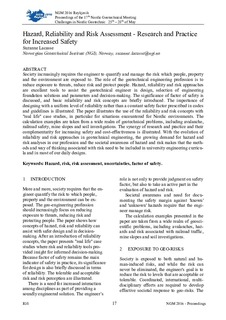Hazard, Reliability and Risk Assessment - Research and Practice for Increased Safety
Chapter
Published version
Permanent lenke
http://hdl.handle.net/11250/2465332Utgivelsesdato
2016Metadata
Vis full innførselSamlinger
- NGI articles [1061]
Sammendrag
Society increasingly requires the engineer to quantify and manage the risk which people, property and the environment are exposed to. The role of the geotechnical engineering profession is to reduce exposure to threats, reduce risk and protect people. Hazard, reliability and risk approaches are excellent tools to assist the geotechnical engineer in design, selection of engineering foundation solutions and parameters and decision-making. The significance of factor of safety is discussed, and basic reliability and risk concepts are briefly introduced. The importance of designing with a uniform level of reliability rather than a constant safety factor prescribed in codes and guidelines is illustrated. The paper illustrates the use of the reliability and risk concepts with "real life" case studies, in particular for situations encountered for Nordic environments. The calculation examples are taken from a wide realm of geotechnical problems, including avalanche, railroad safety, mine slopes and soil investigations. The synergy of research and practice and their complementarity for increasing safety and cost-effectiveness is illustrated. With the evolution of reliability and risk approaches in geotechnical engineering, the growing demand for hazard and risk analyses in our profession and the societal awareness of hazard and risk makes that the meth-ods and way of thinking associated with risk need to be included in university engineering curricu-la and in most of our daily designs.
